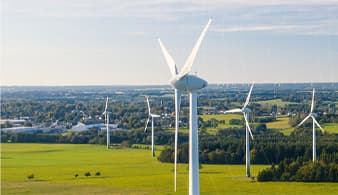Overview
Gas and power, two integral energy sources that underpin all major economic activities, are critical for businesses, which need access to reliable market information, data and prices. This enables them to make more informed decisions relating to their exposure to gas and power sectors.
Our team of market experts provides independent and reliable price assessments, indexes, market data and in-depth analysis. Our prices and market intelligence are used by energy companies, governments, banks, regulators, exchanges and many other organisations. You can benefit from our in-depth knowledge of these markets for better decision-making.
Gas and power market coverage
Argus is a leading independent provider of market intelligence to the global energy and commodity markets. Our price assessments and market intelligence are available for all major gas and power markets across the globe. Explore our coverage most relevant to your business.
Latest gas and power news
Browse the latest market-moving news on the global gas and power industry.
Australia’s Carbon2Nature launches ACCU project
Australia’s Carbon2Nature launches ACCU project
Mumbai, 5 December (Argus) — Carbon2Nature Australia, a subsidiary of Spanish utility Iberdrola's nature-based solutions company, has launched the Talia project to generate Australian Carbon Credit Units (ACCUs) under the Environmental Plantings (EP) method. The project will be developed as a joint effort between Carbon2Nature and Land Life, an Amsterdam-based social enterprise. The first ACCUs are expected to be issued in 2027, Iberdrola Australia told Argus on 4 December. The project is estimated to generate approximately 114,000 ACCUs over its 25-year crediting period in South Australia. EP ACCUs trade sporadically and in limited volumes, but recent transactions have achieved prices in the mid-A$50s/t CO2e — well above the range for generic ACCUs. Argus assessed generic ACCU prices at A$35.70/t CO2e on 5 December. Carbon2Nature is targeting projects capable of providing high-integrity ACCUs such as EP, the firm said. Voluntary demand for these ACCUs is growing, and the value of such projects appear to be long term, it added. By Shribalaji Shenbagaraj Send comments and request more information at feedback@argusmedia.com Copyright © 2025. Argus Media group . All rights reserved.
Golden Pass LNG approved to receive cool-down cargo
Golden Pass LNG approved to receive cool-down cargo
Houston, 4 December (Argus) — QatarEnergy and ExxonMobil's 18.1mn t/yr (2.4bn ft³/d) Golden Pass LNG export terminal in Texas received federal approval today to unload a cool-down cargo, a key step in commissioning the plant. The Federal Energy Regulatory Commission granted the project's request to introduce hazardous fluids into various systems and receive the cool-down cargo. The 174,000m³ Imsaikah has been holding offshore Texas' Port Arthur since 29 November after departing QatarEnergy's 77mn t/yr Ras Laffan export terminal with a cargo on 27 October. The vessel's LNG will be used to cool down Golden Pass' equipment for its start-up process. The three-train project also has federal approval to introduce fuel gas to train 1 and train 1's gas turbine. Feedgas flows to Golden Pass have yet to materially rise. Pipeline nominations on 4 December were just over 8mn ft³, in line with daily flows since mid-October. Flows to LNG plants can be revised later in the day. The project's developers anticipate the facility will start production by the end of the year or in early 2026, with each of its three trains coming on line in six-month intervals. By Tray Swanson Send comments and request more information at feedback@argusmedia.com Copyright © 2025. Argus Media group . All rights reserved.
Arab region warming at twice the global average: WMO
Arab region warming at twice the global average: WMO
London, 4 December (Argus) — The Arab region is warming at twice the global average, with temperatures increasing by 0.43°C per decade from 1991 to 2024, a report from the World Meteorological Organisation (WMO) found today. The world experienced the hottest year on record in 2024. The average temperature across the Arab region in 2024 was 1.08°C higher than the 1991-2020 average, the WMO said. The Arab region saw "intense heatwaves and droughts as well as extreme rainfall and storms", the WMO added. The WMO's report, the inaugural State of the Climate in the Arab Region , covers 22 countries across north and east Africa and the Middle East and was compiled with the Economic and Social Commission for Western Asia and the League of Arab States. The Middle East and north Africa "are among the hottest regions in the world, and climate projections indicate a continued intensification of summer heat extremes in both subregions", the WMO said. The report also included regional climate projections from the UN Intergovernmental Panel on Climate Change. "If the current warming rate continues, mean temperature increase in the Arab region could reach 1.8°C with respect to the 1991-2020 average by 2050", the report found. A handful of climate plans — known as nationally determined contributions (NDCs) — submitted recently by Arab region countries underline the challenges that climate change poses for the region. NDCs submitted over the past few weeks by Bahrain, Qatar and Yemen all note the countries' vulnerability to climate change, including water scarcity. Of the 20 most water-scarce countries globally, 15 are in the Arab region, and climate change is compounding this, the WMO said. Qatar and Bahrain flagged in NDCs their water sectors as a source of emissions , including through power-intensive desalination processes. Bahrain this week noted its "water vulnerability as a challenge that is further intensified by climate change impacts", in its third NDC. By Georgia Gratton Send comments and request more information at feedback@argusmedia.com Copyright © 2025. Argus Media group . All rights reserved.
Qatar presents 2040 climate target to UN
Qatar presents 2040 climate target to UN
Edinburgh, 4 December (Argus) — Qatar has pledged to reduce its emissions by 42mn t of CO2 equivalent (CO2e) by 2040 from a 2019 baseline, with the oil and gas sector "at the forefront of national mitigation efforts". Qatar does not provide its total greenhouse emissions for 2019, but said its climate plan encompasses CO2, methane and nitrous oxide gases. It covers the energy sector — oil and gas, power and water — construction and industry, transport, waste and agriculture, forestry and other land use. Parties to the Paris Agreement were required to submit climate plans, known as nationally determined contributions (NDCs), for 2035 to the UN climate body UNFCCC this year. Qatar had previously targeted emission reductions of 25pc, or 37mn CO2e, by 2030, compared with a business-as-usual (BAU) scenario. BAU scenarios typically assume emissions based on current policies, leaving room for potential increases. The country's emission cuts in its oil and gas sector will rely on "deploying cleaner fossil fuel technologies, developing engineered sinks to store emissions, diversifying the energy mix, and driving operational excellence across existing facilities and infrastructure", according to its climate plan. Qatar is the world's largest LNG producer, with a production capacity of 77mn t/yr, according to QatarEnergy, and its economy is heavily reliant on hydrocarbon revenues. The country's climate plan highlights the country's vulnerability to response measures to mitigate climate change, resulting from its economy's reliance on hydrocarbons. "Qatar is actively working to reduce the socio-economic effects of global climate action," the plan said, adding that it seeks to balance climate goals with national sustainable development. "Despite many efforts and considering its role as a leading producer and exporter of natural gas, Qatar remains significantly vulnerable to climate response measures," it said. Qatar is part of the Arab Group, a negotiating group in UNFCCC climate talks, which is seeking to focus on cutting emissions from fossil fuels, rather than hydrocarbon production and consumption, through increased adoption of carbon capture technologies. The country said it plays "a pivotal role" in supporting other countries' targets by "reliably supplying them with a cleaner alternative to coal and oil and providing a critical backup for intermittent renewables". Qatar's climate plan sees the secure and affordable supply of lower-carbon energy as well as the deployment of carbon capture and storage (CCS) and the management of emissions of energy production as the focus to pursue sustainable development and climate action. The country considers itself to be among the leaders in CCS with its Ras Laffan project, and aims to capture 11mn t/yr of CO2 by 2035. Engineering firm Samsung C&T was recently awarded a contract to build a 4.1mn t/yr CO2 facility to process and store emissions from Qatar's LNG liquefaction plants. Qatar, in its climate plan, highlighted the country's water supply vulnerability to temperature increases and heat. The power and water sector accounts for a large share of the country's emissions. Water scarcity is also responsible for increasing greenhouse gas emissions (GHG) in Bahrain through desalination, although its energy sector remains the main source of emissions, according to the country's new climate plan. The country is heavily reliant on fossil fuels for its energy and revenues, while "limited land availability and competing land-use demands constrain large-scale deployment" for the development of solar energy. Rising demand over the peak summer months this year meant that Bahrain had to import LNG for the first time since commissioning its 800mn ft³/d onshore LNG receiving and regasification terminal in 2020. But it is looking at renewables options and is in talks with Saudi Arabia for a link to a large-scale solar facility. Bahrain said that response measures to climate change "may lead to economic losses that, in turn, hinder Bahrain's ability to pursue effective climate action and achieve broader sustainable development objectives." By Caroline Varin Send comments and request more information at feedback@argusmedia.com Copyright © 2025. Argus Media group . All rights reserved.
Spotlight content
Browse the latest thought leadership produced by our global team of experts.
Explore our gas and power products
Both the natural gas and power services have a long track record of providing well researched pricing, high quality analysis and market intelligence to our clients.
Key price assessments
Argus prices are recognised by the market as trusted and reliable indicators of the real market value. Explore some of our most widely used and relevant price assessments.













